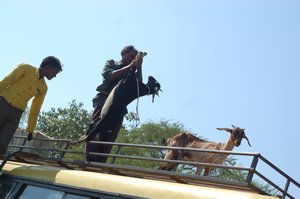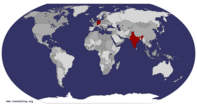Advertisement
Published: March 3rd 2010

 Fellow travellers
Fellow travellers
When their reserved space atop buses are filled with luggage, goats and sheep look for a seat inside.Yuvaraj Rana cut a corner of the polythene packet and drained the transparent liquid into a steel glass. As the dhaba owner returned to the kitchen to make me an egg burji, I took my first drag at mahua. The brew, distilled from mahul flowers abundant in the tribal belt spanning Orissa and adjoining Chattisgarh, felt harmless despite its strong odour.
The last bus was still an hour away. I beckoned for one more packet of mahua. Moonlight mood, my godfather would have said. Inside the highway eatery, a group of travellers drink whisky. Packaged mahua has as many patrons as rum and whisky, Rana said. I had sniffed in the odour as soon as I walked in and was curious to feel the flower drink.
Last evening I walked into a similar dhaba in Bogomunda, a dusty junction which barely seemed to have room for a traveller. Before returning to the nearest town to spend the night, I tried the nearest watering hole, where Gopinath was sharing a 180-ml whisky bottle with a friend. We chatted for a while - he in his native Sambalpuri variety of Oriya and I in Hindi.
When I ordered fish, the

 On the road
On the road
Ranipur-Jharial cluster of hamlets is alternated by barren rocks and green fields.electrician looked pleased. "You are an Odiya," he certified after confirming that I eat chicken and mutton too. The only outsiders he knew, the strictly vegetarian Marwari merchants, would frown at the local diet. When I said I want to go to Ranipur-Jharial, he said there was a traveller’s bungalow in that remote village.
Call it carnivore camaraderie. We bought a bottle of whisky and took a taxi to Jharial. After around 10 kilometres on a dark road, the headlights illuminated a double-storeyed bungalow on a rocky expanse. Hitchcock would love it. The bungalow has all amenities but electricity. Gopi, who wired the building, introduced me to its caretaker Hridanand Kharshel. We shared the drink atop the jeep’s bonnet before Gopi went home.
The moon shines on a wall-like structure a stone throw’s away. This is Jharial’s claim to fame: the Temple of the 64 Joginis.
Kharshel took me home. The young man said he belongs to the Yadavs, the clan of Krishna, implying that it was safe to eat from his house. He narrated the glory of his village as he pushed his bicycle loaded with a sack of rice, along fields and ponds. His father

 Sculpted sandstone
Sculpted sandstone
The temple dedicated to the Nine Planets is one of the 50 plus monuments in Ranipur-Jharial.owns fields here. The family reaps and stores rice for a year. We walk past haystacks and thorny bushes under the moon. A flicker in the distance. A group of villagers huddle around a bonfire in the hamlet, called Balikhamar.
Kharshel’s house is in darkness. Power cut, he says. He stays with his parents, wife, daughter, younger brother and his wife and daughter and two pigeons, which coo from a bar hung at a side of the room plastered with mud and cowdung.
His father and younger brother welcome me and let me sit near a burning mud oven on the room floor. His mother offers peppered black tea. I was shivering despite three pegs of whisky. Dinner served - rice, green gram and what tasted like fish curry. Kharshel’s wife snickered when I asked what fish it was. The delicacy was made of some dried vegetable.
At daybreak, the elder Kharshel accompanied me to the Temple of the 64 Joginis at Jharial. The circular sandstone temple has the dancing Joginis encased in niches - elephant-headed, lion-headed, horse-headed, cow-headed, deer-headed, snake-headed, three-headed and no-headed and so on. Khabira Kharshel tells me that treasure-hunting natives had mutilated the

 Jogini
Jogini
The animal-headed Jogini is one among an original panthenon of 64.sculptures before the archaeological department took over and fenced the temple. There are 59 Joginis left.
At the centre of the temple stands a porch where Siva sits, with son Ganapati and pet Nandi in attendance. In an aerial view the roofless temple would resemble a wheel with 64 imaginary spokes. There’s something about the number. Orissa has another tantric temple dedicated to the 64 Joginis - at Hirapur near Bhubaneswar. There are two more in Bherghat and Khajuraho in Madhya Pradesh.
Beside the tantric temple, small boulders are arranged into two circular patterns. One of them, according to Kharshel, is the Chakravyuha, the impenetrable martial formation of Mahabharatha. I entered the maze like Abhimanyu, Arjuna’s son who learned to breach the formation while he was still in the womb. Unlike the teen warrior, I came out unhurt.
The twin hamlets of Ranipur-Jharial are strewn with stone temples, including the Someswara temple by the lake. About a dozen villagers trawl the lake with a vast net. Freshwater fish with fork-shaped bones rule Oriya cuisine in these parts.
A brick temple rise 60 feet to dominate other temples in the cluster of villages. Fine sculptures are carved

 Dry around a pond
Dry around a pond
Ponds populate western Orissa. There is one at every mile on the road and people are constantly cleaning themselves.into the tower, dedicated to Siva. Archaeological labourers try to reverse years of abandonment, by nurturing a lawn around the red temple.
Kharshel breaks a twig and chews its end to a fine toothbrush. I too get one myself. Then we swim in the cold pond. There is a pond at every mile on the road. “Do you have ponds in your village?” he asks. I told him about the dirty canals in the cities I lived. “How much do you earn?” another one of those innocent rustic queries which made you wish you earned less. Every time an impoverished farmer in a sunburnt hamlet gets curious about urban earnings, I feel guilty.
Back in the Kharshel home, we eat rice flakes with peppered tea. Hridanand had gone to Bogomunda to get provisions for the family. His daughter Namitha and his brother’s daughter Lathika come and greet me. The two-year-old Lathika folds her hands over her head in greetings and then bows low. Women and children touch their foreheads on the ground as soon as an elder in the family appears, even if they are in a dirty bus stand or a cattle-shed.
Balikhamar is one of

 Young Orissa
Young Orissa
Getting ready for lunch. Responsibilities come early in rustic life. From Balikhamar.the nondescript hamlets living under the shadow of their slightly better-known neighbours - Ranipur and Jharial, separated by acres of fields and sandstone expanses. In Ranipur lies a long sandstone slab, called the lucky stone. The length of the slab is never the same when measured twice, the legend goes. If you get it right measuring from this side to that and that side to this, you have the blessings of Hanuman. I didn’t bother to test my luck.
Ranipur has an anganwadi and a primary school. But there are only two teachers for four classes. An adjacent building has been hired by a Bolangir-based non-governmental organisation, which tries to create awareness about government schemes among villagers. Western Orissa’s poorest districts, known as KBK (Kalahandi, Bolangir, Koraput) region, is a fertile ground for armed revolutionaries and funded agencies.
Deceiving monsoons and unplanned irrigation force native farmers to migrate to different parts of India - from Kolkata to Kochi. The Union government’s National Rural Employment Guarantee Scheme has made a difference, says Bikas Sarangi, who works with an NGO. But most of the time, villagers don’t get paid until after two months. A year ago, villagers didn’t even know

 Life in a mill
Life in a mill
A grainy portrait from a rice mill in Kosala.there was such a scheme designed to ensure them a livelihood.
We walked through the dried fields. Women plant seedlings on islands of green. Orissa government’s water conservation project is trying to push up water table by creating check dams on the shallow river. Horrid dry spells had devastated this area in the past.
Kharshel and I reach a village called Kosala, which has a rice mill. People come here to get husk removed from the grain and make flakes of rice. A mill worker happily singing an Oriya tune suddenly stops as he spots the outsider. Local boys persuade him to go on.
Kosala is a village of weavers. Almost every other house has a handloom and colourful festoons of threads hanging all over. Men and women are constantly at work. They sell these unique saris at Rs 200 a piece to merchants who come from Titlagarh and Patnagarh. At the other end of the village, packets of mahua and pan litter a seemingly abandoned field. Pan is a pan-Orissa phenomenon. Everywhere you go, there are betel shops sometimes called ‘battle shops’.
The Sambalpuri region of Western Orissa is also called Kosala, which the natives

 The heady flower
The heady flower
The abundant mahul flowers are distilled to make the endemic mahua brew.claim was the Ramayana-era kingdom where Rama’s mother Kousalya was born. The namesake village looked an unlikely place for a queen to live despite the kaleidoscope of colorful saris in the making.
Group of labourers are engaged in random toil. Must be the NREGS. Some prepare a field for sowing, some make a road and some others clean a pond.
We returned to Balikhamar by noon. Women mix cowdung and mud to give a coating to their bamboo huts. Older girls rummage rice for pebbles while yelling at straying younger siblings. Children wait for lunch. Kharshel introduced me to the village elder, who spoke little and smiled a lot.
Hridanand was back. After lunch, he offered to drop me on his bicycle at Mondpather, or the place of heads, where Kousalya’s bodyguards would leave their victims’ chopped heads. It’s a tri-junction. The road to the right leads to Bogomunda, where I landed last night. I had to go the other way. I hitchhiked on a motorcycle up to Sindikala and walked up to Chandotara across the river. Yuvraj Rana and his boys were waiting for the evening rush of guests at the dhaba. After an hour of mahua-magnified memoirs, I boarded the last bus - with no back rests attached to worn-out seats - to Bhavanipatna.
Advertisement
Tot: 0.117s; Tpl: 0.019s; cc: 12; qc: 62; dbt: 0.0724s; 1; m:domysql w:travelblog (10.17.0.13); sld: 1;
; mem: 1.2mb









